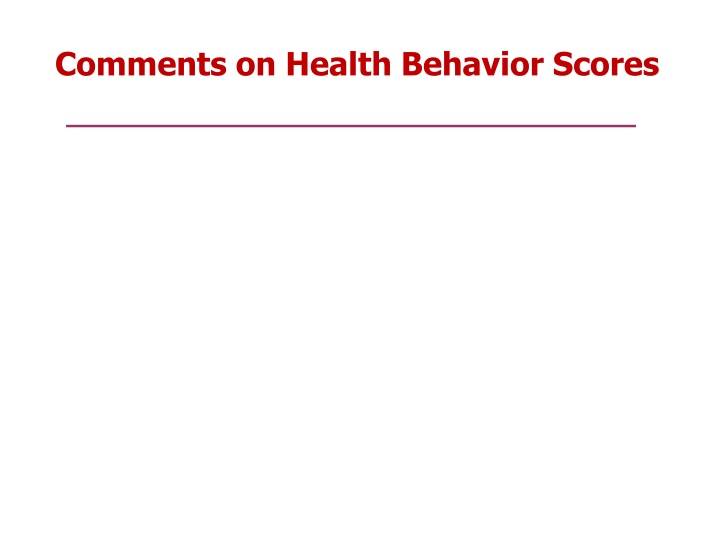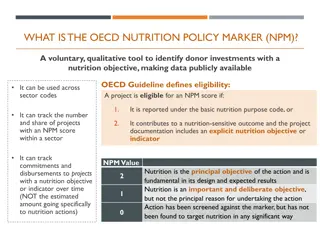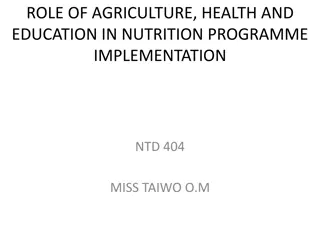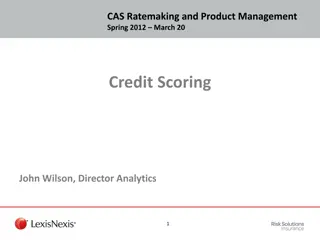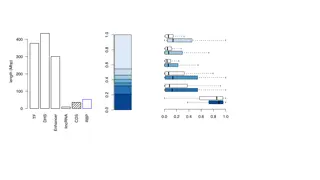Comments on Health Behavior Scores: Understanding Nutrition Studies
Many nutrition studies face challenges in reproducibility and interpretation. Explore the various scoring systems for dietary intake and the importance of creating healthy eating indexes. Learn about the Healthy Eating Index (HEI) and its components, scoring standards, and impact on assessing diet quality according to Federal guidelines.
Download Presentation

Please find below an Image/Link to download the presentation.
The content on the website is provided AS IS for your information and personal use only. It may not be sold, licensed, or shared on other websites without obtaining consent from the author.If you encounter any issues during the download, it is possible that the publisher has removed the file from their server.
You are allowed to download the files provided on this website for personal or commercial use, subject to the condition that they are used lawfully. All files are the property of their respective owners.
The content on the website is provided AS IS for your information and personal use only. It may not be sold, licensed, or shared on other websites without obtaining consent from the author.
E N D
Presentation Transcript
Background Many studies look for magic bullets Red meat meta analysis done at TAMU No statisticians experienced with nutritiion Non-significant effect, and interpretation that red meat is just fine for you Harvard goes berserk WHI clinical trial emphasizing saturate fat last big dietary clinical trial P-value 0.07, many, may millions of $$
Background The only thing that is consistent is the lack of reproducibility in epi studies It is one at a time But nutrition is highly multivariate I think one at a time studies (epi or clinical trials) are just silly Nutritionists idea is to get a score of healthy diets
Background There are many scoring systems for dietary intakes, with different aims Healthy Eating Index (2005, 2010, 2015) Alternative Healthy Eating Index Dot-Dash scores Mediterranean Diet Scores World Cancer Research Fund/American Institute for Cancer Research (WCRF/AICR) scores .etc
Background They give consistent results across many studies (the Pooling Project)
Epi and Index Systems The basic idea of these scores is to create them based on literature research Emphasize: ONE scoring system, many forms of diets Once developed, they are then applied to a host of diseases and populations (e.g., men and women, smokers vs nonsmokers, etc.) Here is the HEI-2005 scoring system
THE HEALTHY EATING INDEX (HEI) is a measure of diet quality that assesses conformance to Federal dietary guidance. The original HEI was created by the U.S. Department of Agriculture (USDA) in 1995. Release of new Dietary Guidelines for Americans in 2005 motivated a revision of the HEI. The food group standards are based on the recommendations found in My Pyramid (see Britten et al., Journal of Nutrition Education and Behavior 38(6S) S78-S92). The standards were created using a density approach, that is, they are expressed as a percent of calorie or per 1,000 calories. The components of the HEI-2005 and the scoring standards are shown below. Health Eating Index 2005 component and standards for scoring Maximum points Standard for maximum score Standard for minimum score of zero Component Total Fruit (includes 100% juice) 5 No Fruit 0.8 cup equiv. per 1,000 kcal Whole Fruit (not juice) 5 No Whole Fruit 0.4 cup equiv. per 1,000 kcal Total Vegetables 5 1.1 cup equiv. per 1,000 kcal No Vegetables Dark Green and Orange Vegetables and Legumes No Dark Green or Orange Vegetables or Legumes 5 0.4 cup equiv. per 1,000 kcal Total Grains 5 3.0 oz equiv. per 1,000 kcal No Grains Whole Grains 5 No Whole Grains 1.5 oz equiv. per 1,000 kcal Milk 10 No Milk 1.3 cup equiv. per 1,000 kcal Meat and Beans 10 2.5 oz equiv. per 1,000 kcal No Meat or Beans Oils 10 No Oil 12 grams per 1,000 kcal Saturated Fat 10 7% of energy 15% of energy Sodium 10 0.7 gram per 1,000 kcal 2.0 grams per 1,000 kcal Calories from Solid Fats, Alcoholic beverages, and Added Sugars (SoFAAS) 20 20% of energy 50% of energy
Global Index Systems Crucially, these index systems are to be used across many diseases and mortality outcomes They are very popular in nutrition because they score the complex nature of dietary intakes Multiple patterns of intake have much the same risks of various cancers or other chronic diseases Nutritionists do not think that there is only 1 magic diet (kale )
Global Index Systems Dietary scoring systems recognize, for example, that there is not a 1-to-1 relationship between cancers and dietary patterns Different diets can be equally effective at lowering risk In diet, trying to find the magic combination makes no sense
Global Index Systems Diet scores are traditionally built on literature review and expert knowledge
Global Index Systems Two of my statistical papers on diet: Ma, et al, JASA, 2007 Using data to create the scores Based on single index models Easy in the case that the SIM is linear Kravitz and Carroll, STAT, 2020 Applying some sort of model selection criterion to ask what dietary components actually matter Empty calories?
Global Index Systems Physical Activity scores Uses AARP data and a physical activity questionnaire (no wearable device data in the study) Keadle, et al, MSSE 2020 The AARP Study is of people aged 50-75, so not many do a lot of vigorous PA
Global Index Systems The scores for the best activity sums to 100 At least for mortality, PAQ has a much stronger signal than dietary observations We used data and a R package called scar (smooth constrained additive regression) Nonparametric MLE with shape constraints
Global Index Systems We used scar on the AARP PAQ The functions are piecewise linear The R package scam does the same thing, but more smoothly.
Global Index Systems Maximum scores Moderate PA: 30 Mod-Vig Household: 25 No television: 15 Vig: 10 8 hours sleep: 8 Non-TV sitting: 5 Light-intensity household: 4 Weight training: 3
Global Index Systems Clearly AARP is a special study It only has self-report I want to do it for accelerometers, across multiple studies Ciprian and I have started a research project to do so
Under the Hood The basic idea, for mortality say You have a collection of variables for PA, sedentary and sleep: call them X You have demographic and other risk factors that would be in any analysis, Z You have an outcome, such a mortality, Y Your have say 2 populations to work with, men and women, k=1,2
Under the Hood In the simplest format, for k = 1,2, you seek a function S such that T T k pr(Y =1|X ,Z )=H{ +S (X , +Z } ) k k k 0k k xk z k S(X , ) The scoring system is Crucially, it does not depend on k, the population It codifies practice: build a score, apply to different populations Obvious to extend to different diseases k
Under the Hood Model T T k pr(Y =1|X ,Z )=H{ +S (X , +Z } ) k k k 0k k xk z k There are obvious model identification issues, but they are merely technical (I do technical ) There are obvious questions about how to form S(X , ) k Fine, fun challenge, but need to keep it simple
General Idea The main conceptual issue is to buy into the idea that you want a single scoring system that applies across multiple populations Nutrition has bought into this in a big way While they do not express this technically, they know that there is no 1-to-1 function of dietary intakes that best predicts multiple diseases Jill Reedy and others at NCI
